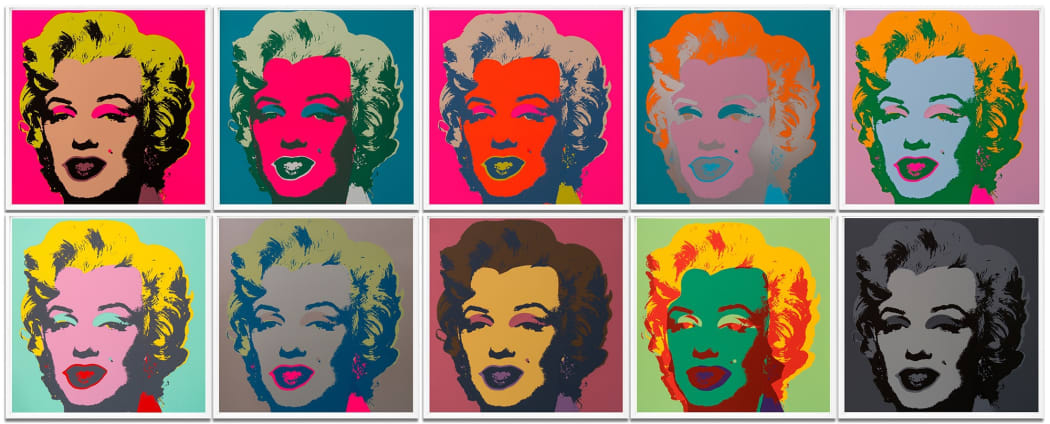
Celebrity Culture
Fame, as described by Google, means “the state of being known or talked about by many people, especially on account of notable achievements.” Warhol is perhaps best known for his portraits of celebrities, which include famous figures such as Marilyn Monroe, Elvis Presley, and Elizabeth Taylor. These works often use bright, contrasting colours and repetitive imagery, highlighting the obsessie nature of the public towards stardom and society’s interest in fame. Indeed, through his primary subjects of celebrity one can see how Warhol uses such figures to draw attention to notions of fame allowing us to reflect on what fame is, why these figures are famous and what fame means.
Warhol's use of silkscreen printing allowed him to reproduce images multiple times, mimicking the mass production methods used in advertising and media. This technique emphasised the idea of fame as a manufactured and reproducible commodity. By choosing this method, Warhol blurred the lines between fine art and commercial art, questioning the originality and uniqueness traditionally valued in art. Indeed, this ability to quickly and accurately reproduce images itself was a commentary on the ephemeral nature of fame, after all, Warhol famously quipped "In the future, everyone will be world-famous for 15 minutes." Warhol’s relation to his images is curious however as, through his commodification of celebrity in art and his own success, Warhol becomes a celebrity in his own right - a space he seemed delighted to inhabit. Warhol in a way is contradictory in nature. His work, whilst never directly critiquing fame, has come to stand for mass commodification of art and an within the shyness of the character created by the artist there seems to be a sense of hypocrisy p a desire for fame yet a sense of fragile vulnerability as to hiding ones true self.
Consumer culture
Warhol’s work often juxtaposed consumer goods with celebrity images, suggesting that both were subject to the same processes of marketing and commodification. Famous works like the "Campbell's Soup Cans" series draw parallels between the consumption of products and the consumption of celebrity personas. There is a deification of the American society that Warhol inhabited with, not only celebrity portraits, but brands and products being elevated to almost olympic levels. It is this use of products, everyday and accessible, in his art which allows Warhol to create discussions around value, worth and, as the images go beyond what the products are, the sum of their values, Warhol skillfully uses the power of the brands to comment on the consumerist, post-war society and what it values. With society of the 1960’s becoming less god-dearing and more atheistic, religion’s importance and place in society was being questioned and what better way to replace the premise of external life than with cons who were destined, through fame, to live forever. Fame, as explored through Warhol’s interest in consumer goods, is packaged, sold, and consumed by the masses - the altar of fame subsequently serving up salvation from the mundane.

Irony
Warhol himself became a celebrity, known as much for his persona as for his art. He cultivated an enigmatic public image, often making ironic statements about fame, such as his famous prediction, "In the future, everyone will be world-famous for 15 minutes." His persona and lifestyle, including his social circles and parties at The Factory (his studio), became part of his artistic output, blurring the boundaries between art and life. Indeed, Warhol’s persona was as much a creation as his artworks and his affected mannerisms and behaviour became as well known as the art that he produced.
It was not only the brighter elements of fame Warhol explored through his works. Indeed, Warhol explored the notion of fame in all its guises and moved beyond the “positive” element of fame as told through the American Dream. Some of Warhol’s work also explores the darker aspects of fame, including the fleeting nature of celebrity and the tragedies that often accompany it. His "Death and Disaster" series features images of car crashes, electric chairs, and suicides, commenting on the voyeuristic consumption of tragedy in the media.

By repeating images of tragic events, Warhol comments on the media's role in desensitising the public to death. The repetitive technique, often using silkscreen printing, emphasises how frequently such images are reproduced in the media, reducing their impact. There is a dichotomy in death and how it is presented in the media. Death, a taboo subject for many cultures around the world, is often presented in a frivolous nature - personified and distant - making such grizzly and shocking events that tend to make the nes feel almost over worldly.
Warhol’s darker work often reflects on the suddenness and unpredictability of death, exploring how life can be abruptly and violently ended. His images of car crashes and other disasters force viewers to confront the fragility of life.
Warhol's own near-death experience after being shot in 1968 profoundly affected his work. His subsequent pieces often reflect a more personal engagement with mortality and the vulnerability of life. Indeed, his approach to work changed dramatically as he began to distance himself from the unpredictable Factory set of individuals and began to take more commissions, in particular, celebrity commissions. Fame it seemed, at this part of this career, allowed Warhol to shelter from threats - be they real, imagined or existential.
Andy Warhol’s treatment of fame is multifaceted, encompassing admiration, critique, and irony. Through his innovative use of techniques and his exploration of celebrity and consumerist culture, Warhol highlighted the complexities of fame in modern society. His work serves as both a celebration and a critical examination of the ways in which fame is produced, consumed, and experienced, making a lasting impact on the art world and beyond. Discover original Andy Warhol art for sale or contact Andipa editions to buy Andy Warhol prints via sales@andipa.com or call +44 (0)20 7589 2371.
